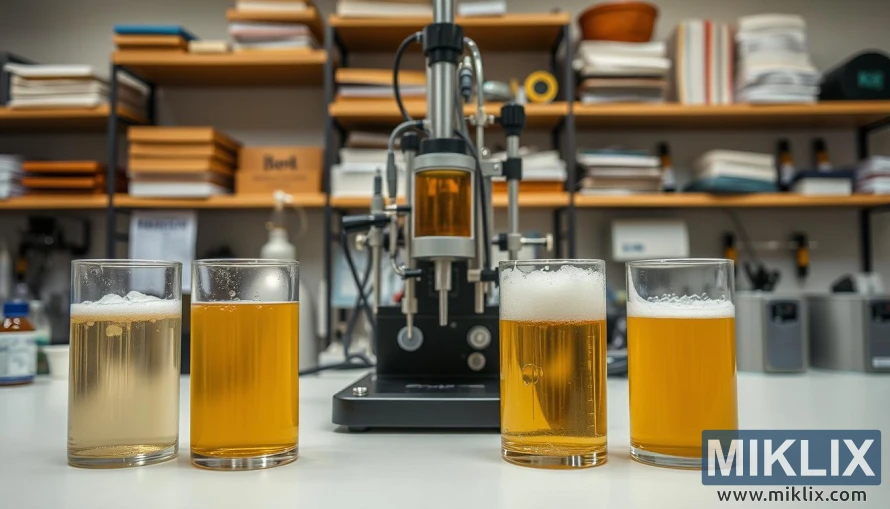Image: West Coast Yeast Fermentation Study
Published: July 20, 2025 at 11:31:10 AM UTC
Last updated: September 27, 2025 at 9:54:51 PM UTC
A lab displays beer fermentation samples with various West Coast yeast strains, highlighting analytical research and flavor profile differences.
This image captures a moment of meticulous experimentation in a modern brewing laboratory, where science and craft converge to explore the nuanced behavior of West Coast yeast strains. The composition is thoughtfully arranged, drawing the viewer’s eye from the bubbling activity in the foreground to the analytical precision of the equipment in the middle ground, and finally to the scholarly backdrop that frames the entire scene. At the heart of the image are five clear glass beakers, each filled with a different sample of fermenting beer. The liquids vary subtly in hue—from pale amber to rich golden tones—suggesting variations in malt composition or fermentation progress. Within each vessel, bubbles rise steadily to the surface, forming delicate foam layers that hint at the metabolic vigor of the yeast cultures at work.
These beakers are not just containers; they are windows into the dynamic process of fermentation. The differences in foam density, bubble size, and liquid clarity offer immediate visual cues about the performance of each yeast strain. Some samples exhibit vigorous carbonation, with dense foam caps and rapid bubbling, while others show a more restrained activity, perhaps indicating slower attenuation or a different flocculation profile. This comparative setup allows researchers to observe and document how each strain behaves under identical conditions, providing valuable insights into their suitability for specific beer styles, especially those that demand clean, crisp finishes and expressive hop character—hallmarks of the West Coast brewing tradition.
In the middle ground, a central piece of scientific equipment stands as a symbol of precision and control. Likely a texture analyzer or a foam stability tester, the device is equipped with sensors and measurement tools designed to quantify physical properties such as head retention, carbonation levels, and viscosity. Its presence underscores the analytical nature of the experiment, where subjective tasting is complemented by objective data. The apparatus is clean, modern, and clearly integrated into a workflow that values repeatability and accuracy. It bridges the gap between traditional brewing intuition and contemporary scientific rigor.
The background adds depth and context to the scene. Shelves lined with reference books, binders, and brewing supplies suggest a space dedicated to continuous learning and refinement. The materials are well-organized, reinforcing the professionalism of the environment and the seriousness of the research being conducted. This is not a casual homebrew setup but a facility where each variable is tracked, each result recorded, and each batch evaluated with care. The lighting throughout the image is soft and even, casting a neutral glow that enhances visibility without overwhelming the senses. It creates a clinical atmosphere that is nonetheless warm and inviting, a place where curiosity thrives and innovation is born.
Altogether, the image conveys a narrative of exploration and expertise. It celebrates the complexity of yeast behavior and the importance of understanding how different strains influence the final product. Through its composition, lighting, and detail, the image invites the viewer to appreciate the intersection of biology, chemistry, and artistry that defines modern brewing. It is a portrait of fermentation as a living process—one that demands attention, respect, and a relentless pursuit of excellence.
The image is related to: Fermenting Beer with Mangrove Jack's M44 US West Coast Yeast

